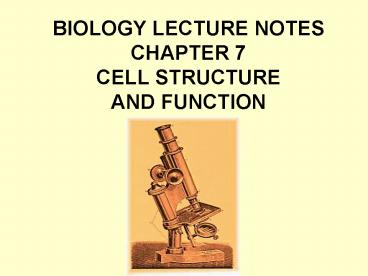BIOLOGY LECTURE NOTES CHAPTER 7 CELL STRUCTURE AND FUNCTION - PowerPoint PPT Presentation
1 / 12
Title:
BIOLOGY LECTURE NOTES CHAPTER 7 CELL STRUCTURE AND FUNCTION
Description:
Site of cellular respiration the process that. releases energy by breaking down food molecules ... This is called cellular respiration. ATP = adenosine triphosphate ... – PowerPoint PPT presentation
Number of Views:145
Avg rating:3.0/5.0
Title: BIOLOGY LECTURE NOTES CHAPTER 7 CELL STRUCTURE AND FUNCTION
1
BIOLOGY LECTURE NOTESCHAPTER 7CELL STRUCTURE
AND FUNCTION
2
- HISTORY OF CELL STUDY
- Anton van Leeuwenhoek first microscope
- observed animalcules.
- Robert Hooke named the cell based on
- observations of cork.
CORK
3
- Schleiden All plants are made of cells.
- Schwann All animals are made of cells.
- 5. Virchow All cells come from pre-existing
cells. - Cell Theory
- All living things are made of cells.
- Cells are the basic unit of structure and
function. - (smallest unit of life)
- 3. New cells are produced from existing cells.
4
- Organisms can be unicellular or multicellular.
- If multicellular, the cells become specialized to
do - specific jobs.
- Cells become organized with a division of labor.
- Cells Tissues Organs Organ
Systems - Organisms
5
Levels of Organization
Muscle cell
Smooth muscle tissue
Stomach
Digestive system
6
- CELL COMPARISON
- PLANT CELL ANIMAL
CELL - cell walls cellulose 1. no cell
walls - chloroplasts 2. no
chloroplasts - large vacuoles 3. small
vacuoles - no centrosomes 4. centrosomes
- no lysosomes 5. lysosomes
- often rectangular 6. irregular
shapes
7
- Two organelles of importance in obtaining
- and using energy are CHLOROPLASTS
- and MITOCHONDRIA.
- (Both organelles contain their own DNA which
- suggests they may have been independent organisms
- at one time.)
- CHLOROPLASTS
- Found only in plants.
- Plants use the energy of light to convert water
and - carbon dioxide into oxygen and high-energy
- carbohydrates sugars and starches.
8
- 6 CO2 6 H2O C6H12O6 6 O2
- (Equation for photosynthesis.)
- Chloroplasts contain sac-like membranes
known as thylakoids where the suns energy is
trapped and transferred to sugar-producing - reactions.
9
- MITOCHONDRIA
- Found in all living cells.
- Site of cellular respiration the process that
- releases energy by breaking down food molecules
- in the presence of oxygen.
- 3. 3811 calories in 1 gram of glucose or 3.811
- kilocalories (what we call calories)
- C6H12O6 6 O2 6 CO2 6
H2O ATP - This is called cellular respiration.
10
- ATP adenosine triphosphate
- A chemical fuel that is formed in mitochondria.
- Energy is released gradually by changing
- ATP ADP P.
- The bond is a high-energy bond.
- ADP P ATP restores the
high-energy bond. - In the presence of oxygen, one molecule of
glucose - produces 36 ATPs. This represents 38 of the
- energy found in glucose. The other 62 is
released - as heat lost to living things.
11
MITOCHONDRION
12
Cytoskeleton
Maintains cell shape and functions in cell
movement.































